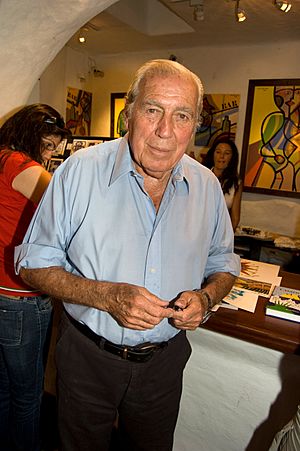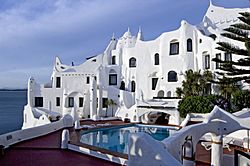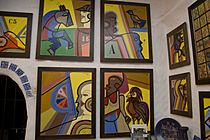Carlos Páez Vilaró facts for kids
Quick facts for kids
Carlos Páez Vilaró
|
|
|---|---|

Carlos Páez Vilaró in 2009.
|
|
| Born | 1 November 1923 |
| Died | 24 February 2014 (aged 90) Punta Ballena, Uruguay
|
| Nationality | Uruguayan |
| Occupation | Painter, potter, sculptor, muralist, writer, composer, constructora. |
| Spouse(s) | Madelón Rodríguez Gómez (1955–61) Annette Deussen (m. 1989) |
| Children | Carlos Miguel, Mercedes, Agó, Sebastián, Florencio, and Alejandro. |
Carlos Páez Vilaró (born November 1, 1923 – died February 24, 2014) was a famous Uruguayan artist. He was a painter, sculptor, and writer. He also created murals and composed music.
Contents
Carlos Páez Vilaró: An Artist's Journey
Carlos Páez Vilaró was born in Montevideo, Uruguay, in 1923. He started drawing in 1939. Later, he moved to Buenos Aires, Argentina. There, he learned about printing.
Discovering Afro-Uruguayan Culture
In the late 1940s, Carlos returned to Montevideo. He became very interested in Afro-Uruguayan culture. He lived in a neighborhood called "Mediomundo." He studied the Candombé and Comparsa dances. These dances are a big part of the culture.
He wrote many songs for these dances. He even led an orchestra. His group's congas and bongos were decorated with his own drawings. His interest in this culture led him to Brazil. Brazil has a large population of people of African descent. In 1956, the Modern Art Museum of Paris invited him to show his art. Later that year, he visited Dakar, Senegal, in Africa.
The "Grupo de los 8" Artists
In 1958, Carlos was part of a group called "Grupo de los 8." This group of Uruguayan artists wanted to show new styles in painting. Other artists in the group included Oscar García Reino and Miguel Ángel Pareja.
In 1960, they were invited to an international art show. This show was at the Buenos Aires Museum of Modern Art. Famous artists like Willem de Kooning also showed their work there. The "Grupo de los 8" helped change Uruguayan art. Their works are now in museums around the world.
Creating the "Roots of Peace" Mural
In 1959, Carlos Páez Vilaró got a special job. He was asked to create a mural for a tunnel. This tunnel connected a new building to the Organization of American States in Washington, D.C..
The mural was first planned to be 15 meters long. But when it was finished in 1960, it was huge! It measured 155 meters long and almost 2 meters high. It was called Roots of Peace. He repainted the mural in 1975 because of damage from humidity.
Casapueblo: A Living Sculpture

In 1958, Carlos bought land by the sea in Punta Ballena, Uruguay. He built a small wooden house there. Over time, this house grew into "Casapueblo" (which means "House-Village").
Casapueblo is a large, white building. It looks like the mud nests made by local hornero birds. It became his home, art studio, and a museum. He kept adding to the building, sometimes making a room for a special guest. Later, he opened part of Casapueblo as a hotel for tourists. It is now a very popular place to visit in Uruguay.
Art and Travel Around the World
Carlos Páez Vilaró stayed connected with European and African cultures. He was friends with people like Brigitte Bardot and Pablo Picasso. In 1967, he started a film production company. He traveled to many West African countries. There, he made a documentary film called Batouk.
A Father's Search: The Andes Plane Crash
Carlos Páez Vilaró had three children from his first marriage. One of his sons was Carlos "Carlitos" Páez Rodríguez. In 1972, Carlitos was on a rugby team flight. The plane, Uruguayan Air Force Flight 571, crashed in the Andes mountains.
Carlos Páez Vilaró joined the search and rescue mission. Out of 45 passengers, only 16 survived. His son Carlitos was one of them. Carlos was reunited with his son after 72 days.
Later Life and Artworks
Carlos Páez Vilaró continued to create many murals and sculptures. He made art for government buildings, company offices, and private homes. He created 12 murals in Argentina and 16 in Brazil. He also made 11 murals in the United States and 30 in his home country of Uruguay. He also made art in Africa and the Polynesian islands.
He designed a special chapel for a cemetery in San Isidro, Buenos Aires. This chapel had no crosses or headstones. He thought this chapel was his "greatest work." In his last years, he lived between Casapueblo and his home in Tigre.
Carlos Páez Vilaró passed away on February 24, 2014. He was 90 years old. His son said, "I've never seen a guy who works that much... He worked up until yesterday."
See also
 In Spanish: Carlos Páez Vilaró para niños
In Spanish: Carlos Páez Vilaró para niños
Images for kids





